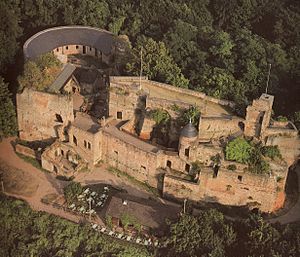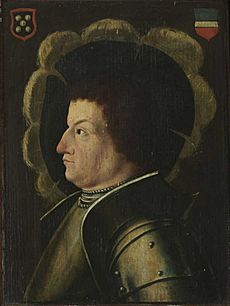Nanstein Castle facts for kids
Quick facts for kids Nanstein Castle |
|
|---|---|
| Native name German: Burg Nanstein |
|

Ruins of Nanstein Castle
|
|
| Location | Burgweg 1 66849 Landstuhl, Germany |
| Built | c. 1152 |
| Built for | Frederick I of Germany |
| Current use | Ruin, tourist attraction, festival hall, music venue, open-air theater, restaurant |
| Architectural style(s) | Gothic, renaissance, other |
| Governing body | Municipal Association of Landstuhl |
| Owner | Government of Rhineland-Palatinate |
| Lua error in Module:Location_map at line 420: attempt to index field 'wikibase' (a nil value). | |
Nanstein Castle (called Burg Nanstein in German) is an old castle that is now mostly in ruins. It sits high above the town of Landstuhl, Germany. This castle was built a long, long time ago in the 12th century. It's made from red sandstone rock. A famous knight named Franz von Sickingen once owned it. He was seriously injured during a big fight at the castle in 1523. Today, parts of the castle have been rebuilt, and it's a popular place for visitors.
Contents
History of Nanstein Castle
Building the Castle
Nanstein Castle was built around 1152. It was ordered by Frederick Barbarossa, who was a powerful ruler of Germany. This castle was a "spur castle," meaning it was built on a ridge or spur of a hill. It stood on a high sandstone cliff, about 49 feet (15 meters) tall.
The castle was an important part of the defenses for the Hohenstaufen family. They were a powerful royal family in the Holy Roman Empire. Nanstein Castle helped protect their lands in the southwestern part of the Palatinate region.
A Knight's Story: Franz von Sickingen
In the 16th century, a brave knight named Franz von Sickingen owned Nanstein Castle. He was also a supporter of the Reformation, a big religious movement at the time. Sickingen made many changes to the castle. He turned it into a strong fortress, or "citadel." He wanted it to be able to stand against the powerful cannons and artillery used in battles back then.
However, in 1523, Nanstein Castle was attacked. This attack happened during a conflict known as the "Knights' War." Three powerful leaders led the attack: the Archbishop of Trier, the Palatine Elector Louis V, and Philip, Landgrave of Hesse. During this big fight, Franz von Sickingen was seriously injured. He later died from his wounds.
Rebuilding and Later Years
After the siege, Sickingen's sons got the castle back in 1542. It was given to them as a "feudal tenure," which means they were allowed to use the land and castle. They immediately started to rebuild it. They rebuilt it in the beautiful Renaissance style, which was popular at the time.
But the castle faced more destruction. In 1668, another powerful ruler, Elector Charles Louis, captured the castle. He had parts of it destroyed again. Then, in 1689, French troops caused even more damage.
Over the centuries, some repairs were made to Nanstein Castle. However, it has remained mostly a ruin. Today, it stands as a reminder of its long and eventful history. It is a popular place for people to visit and learn about the past.


